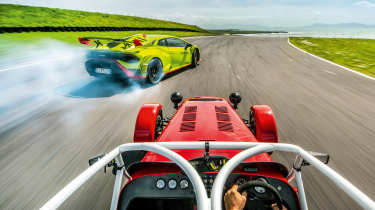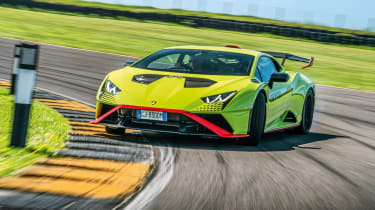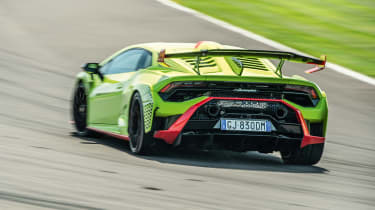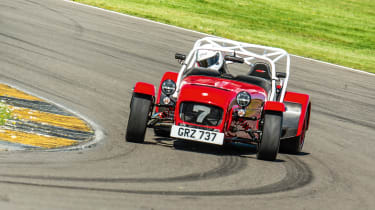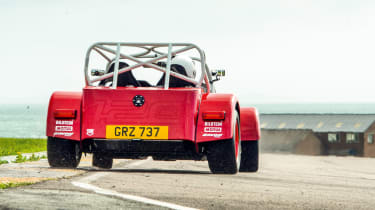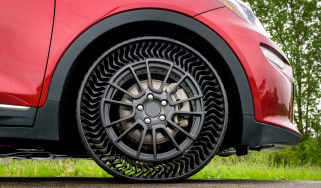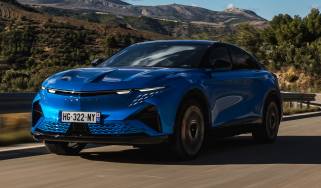Lamborghini Huracán STO v Caterham Seven 420 Cup
The STO and 420 Cup are two very different ways to get your trackday thrills, both delivering the purest performance possible, as Jethro Bovingdon discovers
As Ferrari's 987bhp SF90 Stradale warps around the circuit, literally leaping out of corners and piling on speed in a frankly alien, frightening manner, the STO and 420 Cup pull the crowd from the pit-wall down into the pitlane the moment their engines fire. Compared with the likes of the SF90, these are simple cars. The 420 Cup is simple compared with any car. But they have a magnetism. They’re headliners in their own right.
Of course, a 5.2-litre V10-powered supercar and a raucous, highly tuned four-cylinder Seven could scarcely be more different. In terms of mass, weight distribution, driving position, power and torque, control weights and gearbox operation they’re worlds apart. What they share is crucial, though. Each is absolutely focused on performance and creating a unique and unforgettable driving experience. Most of all, they challenge the person holding the steering wheel rather than acting on algorithms and mu calculations and powertrain strategies. Oh, and they really love to rev. They’re trackday cars, pure and simple. This isn’t a comparison test. It’s a celebration.
> Renault Mégane RS v Nissan GT-R Nismo – evo heroes fond farewell
A celebration. In the past, this term has been used to placate PRs who don’t want their car to be thrown into a group test against a ‘rival’ that is too good/cheap/expensive (delete as applicable). And you might think Lamborghini had placed some stringent terms to our loan, especially as the STO is photographed here with a Caterham costing from £55,000. The STO costs £260,012 without an option. However, for once ‘celebration’ means just that. There are conclusions to be drawn but none is more important than the simple fact that these are very special cars. Even better, it takes less than a lap in either to know you’re in the presence of greatness.
Earlier in the day, all of our cars rolled onto the weighing scales one-by-one, each brimmed with fuel. The Lamborghini, despite its one-piece carbonfibre front clamshell, thin glass and total lack of sound deadening came in at 1548kg (Lamborghini claims 1339kg ‘dry’), with a 41.6/58.4 front/rear weight distribution. It’s best to think of the STO as ‘lightened’ rather than truly lightweight, then. Luckily it has 631bhp at 8000rpm and 417lb ft of torque to push it along. With the rear wing set to maximum rake, Lamborghini also claims the STO produces 420kg of downforce at 174mph.
We could have probably lifted the £54,990 420 Cup onto the weighing pads rather than rolling up the metal ramps. With 33 litres (23.7kg) of fuel on board it comes in at 578kg, shared 49.1/50.9 between the front and rear axles. Its 2-litre Duratec engine produces 210bhp and 150lb ft and it drives through a six-speed Sadev sequential gearbox and limited-slip differential. It’s also fitted with very sticky Avon ZZR tyres. Downforce? Depends how much the driver weighs…
There are other numbers to interrogate. Peak speeds, minimum apex speeds, lateral G force and overall lap times. They can wait. In the STO there is no time to think beyond the next gearshift, the next braking point, the next time you feel the nose lock onto line and the rear follow obediently before it gently, inevitably, deliberately starts to adopt yaw. The ‘U’ word has been levelled at Lamborghini perhaps more than any other sports- or supercar manufacturer, but the STO is a whole different animal. Slow corners or fast, it wants to oversteer.
The sharp, on-the-nose balance seems perfectly suited to a car that is ferocious in every sense. And, my god, that V10 is almost overwhelmingly exciting. Response is instant, the noise pure and brutally loud, and yet the delivery is wonderfully precise. The engine’s character is mirrored in the whole experience. The STO can feel shockingly violent on the one hand, but the quality and accuracy just below the befuddling sensory overload provides absolute control. Intimidation becomes confidence almost like a light switch.
The seven-speed dual-clutch gearbox is a perfect match for the V10. Shifts are fast and the paddles beautifully responsive, as is the quick, fixed-rate steering and the quite stupendous Brembo CCM‑R brakes. The STO just does what you ask of it. No lag, no delay. At times this can make the car feel just a little jumpy. Usually when a small steering correction is required. It’s generally smaller than you think, and when grip comes back, the car obeys your mistake. Within a few laps those errors disappear and the STO just flows. It really does have the most delicious balance.
Despite competition-car looks and Bridgestone tyres marked ‘Race’ the STO is not one of those cars that has mechanical grip to blow your mind. The Bridgestones don’t look as extreme as the benchmark Cup 2, let alone the near-slick 2 R, but they’re a crucial part of the STO’s expertly judged balance between power and grip. The data reveals that the STO’s corner speeds are almost identical to those of the 911 GT3 Touring running P Zero Corsa tyres. We know the 992 GT3 has very good grip and stability so that’s a strong result. Better still, in the middle of the corner you have an extra 128bhp to play with and a chassis that allows stunning accuracy once the rear tyres are over-speeding. It’s an absolute riot.
Almost unbelievably, the Caterham is just as exciting, even more challenging and has a bizarrely similar balance: the front is nailed on line and the rear is completely dictated by throttle inputs. Of course, it requires a little more dedication to reach this point than most cars. Even a luminous Lamborghini. First, you need to climb onto the top of the (optional) roll-cage. Now dangle legs through and lower yourself down, pausing to stand on the seat and then wriggling legs into the footwell until you’re clamped into position between transmission tunnel and the outer bodywork. Click the steering wheel into position, fasten the four-point harness and you’re ready to go. At this point it really stings if you’ve left the keys in the kitchen…
The sequential ’box is easy to use but does require confidence and a bit of brute force. From neutral (signified on a small digital read-out), depress the clutch and tug firmly back on the lever. You’ll feel a clunk and the hard, flat tone of the engine will drop just a little. Pulling away is easy. The engine might have over 100bhp per litre but it’s plenty torquey enough to get the featherweight Caterham rolling without any throttle input at all. Now it’s just a matter of pulling hard for upshifts or slamming the lever forwards for downshifts. There’s no clutch required on the way up but don’t expect auto-blip here. Learn to heel-and-toe or expect to spin. Frequently.
The 420 Cup is based on the top-level Seven Championship UK 420R racer, only with a bump in power from 180bhp to 210bhp and unique adjustable Bilstein dampers. There are 10 clicks and today they’re set to 9 all around. This is pretty much identical to the racer’s fixed-rate set-up, and it feels just about perfect from the moment I pull out of the pits. Although that realisation is at first completely drowned by the sudden sense of space. Anglesey is huge! Where before I’d try to nibble some inside kerb on the lap’s second corner, a 180-degree right-hander, in the 420 Cup I can put the whole car on it should I want. Every corner suddenly has endless scope for new lines and can be straightened out so easily.
The Caterham’s slight build is such a boon, amplified by the fact you can see exactly where the front wheels are on the track, and enhanced by masses of mechanical grip and wonderfully responsive steering. The Seven is way more physical to drive than the Lamborghini but the weight of the controls never manifests as reluctance. Input and output are perfectly matched. And, just as in the STO, you are bombarded with information. You sit over the rear wheels, the side-exit exhaust bellowing just to your right, the tiny steering wheel dancing in your hands. Everything is high energy, almost overwhelmingly so. Yet very quickly your senses emerge from a state of emergency and tune into the key messages. Just as with the STO, after a very brief period of acclimatisation the 420 Cup’s frantic capability brings an eerie sense of calm.
And, once you’re on top of it, the Caterham is utterly sublime. The front has so much grip and if you’re confident to really lean on it on turn-in, the rear is instantly alive. Measure the power correctly and you’ll sense the car pivoting, almost as if it’s about to slide into oversteer. But as there’s so little weight to contain and so much grip on hand, the 420 Cup simply stays neutral and allows full throttle unnaturally early. It’s a fantastic feeling, the Caterham just on the edge but never tripping over it.
Get more aggressive and you can create a bigger oversteer angle, yet the car still finds amazing drive and it barely slows you down. Mixing this much precision with such adjustability is rare, and when you add the noise, the sights and sounds and the physical effort to really make this car fly, there’s nothing quite as intense and rewarding. Coming back onto the pit straight, one hand catching a slide, the other grabbing an upshift just as the rear wheels start to clatter over the exit kerbing, I’m not sure I’ve ever felt so heroic in a car. Sounds silly, but this Caterham is just absurdly enjoyable, intense and creates unforgettable moments on every single lap.
Fast, too. At the fastest point on the circuit the Cup is only doing 119.6mph to the STO’s 142.2mph, but it claws back so much time through every turn. For example, its minimum speed through the first corner is 75.2mph to the STO’s 66.4mph. It’s almost 10mph faster through one of the later turns, too, and although the braking points are very similar across the lap, the Caterham always needs to shed less speed and can get back on the power earlier.
In the final reckoning the lap times are just 4/10ths apart. The Lamborghini clocks a 1:12.7 to the Caterham’s 1:12.3. I suspect I could do 100 laps and still not shave much from the STO’s time but there’s clearly more to be had in the 420 Cup. If I’d have hooked up all my best sectors there was a 1:11.8 on the table. Incredible for a car with 210bhp. As it is, the 420 Cup matched the Ariel Atom 3.5R – a car that also weighs circa 550kg, features a paddleshift sequential ’box and has 310bhp. It’s a mighty performance.
There’s normally a clear favourite at this point, but not this time. I can’t recommend either car highly enough.
This story was first featured in evo issue 299.

